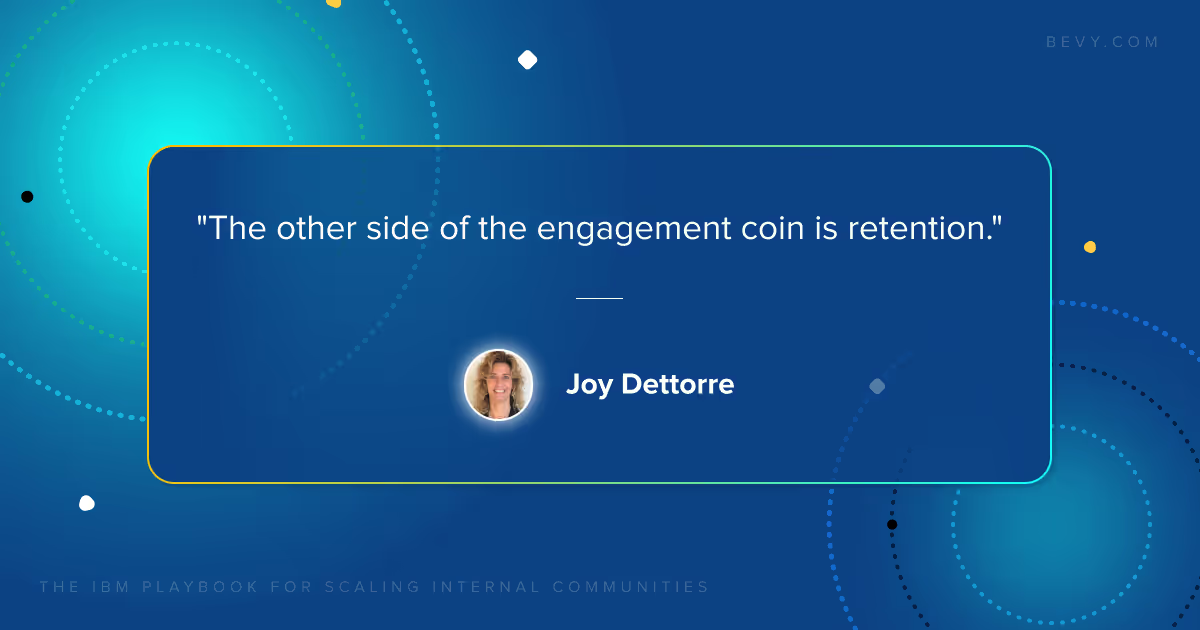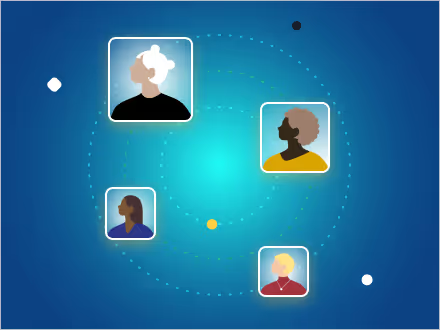On November 9, we hosted our second ERG-focused event. We were joined by Joy Dettorre Global Leader of Diversity & Inclusion and Stephanie Galera, Global Diversity & Inclusion Leader - Workplace Programs and Community Engagement from IBM, and our very own David Spinks, VP of Community at Bevy, was the moderator.
At IBM, employee resource groups are known as BRGs, or business resource groups. As a corporation, they stand behind the purpose of delivering employee-centric programs. IBM has been in the ERG space since 1995, and for the DEI leaders at the time, diversity was a strategy for creating communities of people that had a common cause. The main goal: Create a diverse, inclusive, equitable, and purposeful workplace.
The structure of business resource groups at IBM
When Stephanie entered into the BRG space at IBM, there was no structure in place for people wanting to either enter or exit leadership positions. Now, everyone co-leads together. The BRG programs are directly managed through Human Resources, and the big focuses are on intersectionality and allyship.
By having a place within the Human Resource department, BRG leaders are able to adhere to IBM’s overarching DEI strategy, set general goals as a BRG that align with business objectives, and have supports in place that cover the entire employee lifecycle. Additionally, there are application and funding processes in place.
Business resource groups stay true to core competencies, and are based on philosophies around communities, rather than constituencies. There are three global communities: LGBTQ+, Women, and People with Diverse Abilities (which includes neurodivergents). The other five core BRGs are: Black employees, Hispanic employees, Indigenous employees, Pan-Asian employees, and Veterans.
Why companies need ERGs or BRGs
When it comes to defining “inclusion,” Joy says there are two questions that they consider:
- Do employees have a sense of belonging at work?
- Does the organization celebrate what makes its employees unique and special?
Another big focus of the business resource groups is fostering organizational trust; enabling spaces of trust and compassion.
Having a “common cause” for each community drives passion around people wanting to be a part of something. The results are inclusion, engagement, fairness, and belonging.
Over the course of the pandemic, in particular, levels and ways of engagement have changed. You have to look at a team member’s level of engagement, alongside levels of absorption and dedication. If they’re part of a BRG and these things are improving as a result, retaining that team member is more likely than not.
How to measure the success of your employee resource group
At IBM, there are two main ways of measuring employee engagement across the organization, as well as within their BRGs. Everyone is asked to participate in an annual employee engagement survey, as well as mini pulse surveys within the company Intranet.
In order to understand where employees are at, it’s important to look at things year over year, and in the moment with more spontaneous questionnaires. You want to address current issues and events, and use your employee resource groups as safe spaces to discuss these issues.
Stephanie says that it’s important for BRG leaders to be sensitive to the needs of the community. The events and experiences that are offered, as well as the response to initiatives, are a clear means of measurement. If there’s a cause that’s important to members of the BRG, there’s always the option to directly measure social impact through acts of charity.
They’re also looking at factors like attention, attrition, and engagement. Across their internal points system, BRG leaders are an average of five points higher when it comes to the focus on inclusion, and three points more engaged than other employees at IBM. The other side of the engagement coin? Retention.

How to guarantee success for your ERG
They’ve been in the ERG game for a long time at IBM; the first version of the program started in 1995. One thing that’s been implemented since Stephanie joined IBM and began leading a BRG is the creation of a single email address that’s owned by the entire DEI team. They use this to answer questions from all employees instead of being exclusive to BRG members.
When it comes to applications and funding, the processes have been automated. There’s also a handbook that offers an extensive framework around activities and programs that BRGs can use to boost engagement and other success metrics.
The Community and DEI teams that support BRG leaders foster collaboration with executive leadership counsels to set strategic priorities for each community, since challenges vary. A lot of the work centers around ensuring all BRG work together to have successful initiatives across the board.
Q&A period highlights

What does the organizational structure of the groups look like and, if there are leads, are they compensated for their work?
At IBM, they follow a governance model for their business resource groups. To get started, they all needed an executive sponsor to provide championship, guidance, and a co-chair.
Once in a BRG leadership role, you have the chance to take part in leadership development programs. There are also online recognition programs where leaders can use rewards to purchase merchandise and trips through the internal shopping center.
There’s also a Manager’s Empowerment Fund where thanks can be given with cash incentives, and the Leader Rewards Program includes the opportunity to earn specialty LinkedIn badges.
Lastly, the month of August is BRG Appreciation and Awareness Month at IBM.
When an organization is committed to the DEI there are number of instances where you have to engage in difficult uncomfortable conversation about discrimination or unconscious biases. I am wondering how to start that and move about it successfully?
Joy said that it’s about creating an ecosystem where allyship, diversity, equity, and inclusion stretch across. Be an organization where people see themselves working and when they’re actually a part of it, figure out how to live up to that.
Your company’s reputation after people leave is just as important as your reputation after they join. Make people feel valued and included through their lifecycle as an employee. This should not be treated as a “one and done” sort of initiative.
WATCH THE FULL TALK HERE

